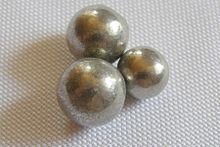
The Mond process, sometimes known as the carbonyl process, is a technique created by Ludwig Mond in 1890, to extract and purify nickel. The process was used commercially before the end of the 19th century, and particularly by the International Nickel Company in the Sudbury Basin. This process converts nickel oxides into nickel metal with very high purity being attainable in just a single step.
Synopsis
This process involves the fact that carbon monoxide combines with nickel readily and reversibly to give nickel carbonyl. No other element forms a carbonyl compound under the mild conditions used in the process.
This process has three steps:
1. Nickel oxide reacts with syngas at 200 °C to give nickel, together with impurities including iron and cobalt.
- NiO(s) + H2(g) → Ni(s) + H2O(g)
2. The impure nickel reacts with carbon monoxide at 50–60 °C to form the gas nickel carbonyl, leaving the impurities as solids.
- Ni(s) + 4 CO(g) → Ni(CO)4(g)
3. The mixture of nickel carbonyl and syngas is heated to 220–250 °C, resulting in decomposition back to nickel and carbon monoxide:
- Ni(CO)4(g) → Ni(s) + 4 CO(g)
Steps 2 and 3 illustrate a chemical transport reaction, exploiting the properties that (1) carbon monoxide and nickel readily combine to give a volatile complex and (2) this complex degrades back to nickel and carbon monoxide at higher temperatures. The decomposition may be engineered to produce powder, but more commonly an existing substrate is coated with nickel. For example, nickel pellets are made by dropping small, hot pellets through the carbonyl gas; this deposits a layer of nickel onto the pellets.
This process has also been used for plating nickel onto other metals, where a complex shape or sharp corners have made precise results difficult to achieve by electroplating. Although the results are good, the toxicity makes it impractical as an industrial process. Such parts are now plated by electroless nickel plating instead.
See also
References
- Mond, L.; Langer, C.; Quincke, F. (1890). "Action of Carbon Monoxide on Nickel". Journal of the Chemical Society, Transactions. 57: 749–753. doi:10.1039/CT8905700749.
- ^ "The Extraction of Nickel from its Ores by the Mond Process". Nature. 59 (1516): 63–64. 1898. Bibcode:1898Natur..59...63.. doi:10.1038/059063a0.
- Annual Report on the Mineral Production of Canada. Canada. Dominion Bureau of Statistics. 1932. p. 88.
Further reading
- "Nickel: The Essentials". WebElements.
- Liptrot, G. F. (1983). Modern Inorganic Chemistry (4th ed.). Unwin Hyman. p. 386.
- Pauling, L. (1964). College Chemistry (3rd ed.). Freeman. p. 658.
- Rawcliffe, C. T.; Rawson, D. H. (1974). Principles of Inorganic and Theoretical Chemistry (2nd ed.). Heinemann. p. 409.
- "Nickel Chemistry". University of the West Indies (Mona).
- Miessler, Gary L. (2014). Inorganic Chemistry (5th ed.). Pearson. p. 492